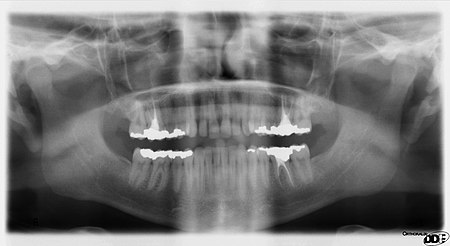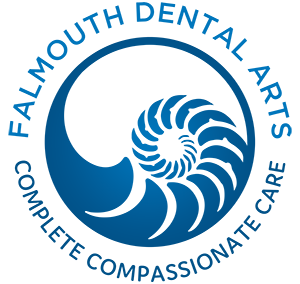
Sep 28, 2021
You brush, you floss, you’ve started scraping your tongue, and you come in for regular check ups. Perhaps you’ve been wondering why you need to get dental x-rays on top of your excellent oral care routine. Are dental x-rays really necessary for your oral health? The answer is yes: dental x-rays are a useful diagnostic tool for Dr. Brunacini and Dr. Karagiorgos and help them detect damage and disease not visible during a general exam. This month we spoke with Dr. Karagiorgos about why dental x-rays are an important part of your oral health care.
Dental X-rays provide dentists the opportunity to identify any potential problems in the mouth. What exactly are you looking for when you review X-rays?
Dr. Karagiorgos: X-rays are a very important diagnostic tool that allow dentists to see more of people’s teeth than what we can see in the mouth with just magnifying lenses and a headlight. With x-rays we can see things like tooth decay between adjacent teeth, we can see if there are any potential problems under the gums, in the bone or in the roots of the teeth.
Are there any types of x-rays that hurt or require special preparation or protection?
Dr. Karagiorgos: Dental x-rays themselves don’t hurt per se. There are conditions in some patients that can make it a little more difficult for those patients to take x-rays. For example, patients with a limited ability to open their mouth, patients that have a very strong gag reflex or some that have larger bony protrusions in their mouths. X-rays have evolved and improved quite a bit over the years. At Falmouth Dental Arts, we have state-of-the-art digital x-ray sensors that allow us to take and immediately see diagnostic images in high resolution, using far less radiation than the previous generation film x-rays.
What are the most serious diseases or conditions that you can prevent thanks to taking regular X-rays?
Dr. Karagiorgos: X-rays can help us routinely detect things like dental decay and tooth infections. X-rays can also help us diagnose very serious general health problems. We can see pathology in the bone like invasive cysts or cancerous tumors. Panoramic films and 3D cone beam x-rays that rotate around the head are commonly used to evaluate the jaw joints or to see wisdom teeth coming in. These x-rays with expanded fields of view can also help us see things like restricted airways, salivary blockages or even calcifications in the circulatory system of the neck which can put patients at increased risk of stroke.
What has been the most surprising thing that you have seen on Dental X-rays?
Dr. Karagiorgos: I just got back from a dental convention where a dentist presented the latest imaging technology. He presented us a slide showing x-rays taken on a 6 year old boy. His images showed what looked like a round metal object in the boy’s left sinus. The x-ray image was of such great quality that we were able to make out George Washington’s bust! It turns out that without anyone’s knowledge, the boy had lodged a quarter so deep into his nose that it ended up in the boy’s maxillary sinus. That was pretty surprising to see, but even more surprising was the very next slide.
It was an x-ray of the sinus of the boy’s 8-year-old brother. Apparently, the brother had a lego brick in the exact same location!
Are there any medical conditions or situations where you advise patients to not undergo x-rays?
Dr. Karagiorgos: Typically, no. Dental X-rays are of lower doses of radiation. They are considered generally safe. That said, we specifically try to limit x-ray exposure to expectant women. We are always weighing the risks and benefits of every treatment, and this includes taking x-rays.
As dentists, we practice the ALARA principle with radiation. ALARA stands for “as low as reasonably achievable”. This principle means that even if it is a small dose of radiation, if there is no direct benefit, you should try to avoid it.
Thank you, Dr. Karagiorgos!
When was the last time you had x-rays of your teeth taken? We recommend routine Bitewings x-rays for adults every 1-2 years depending on decay history, gum health, and dry mouth. For children and teens we recommend it every year. Major films are recommended every 3-5 years for both adults and children to monitor growth and development as well as periodontal health. Call our office today at 207.781.5900 to make your appointment!
*Image courtesy of www.wikipedia.org
Aug 27, 2018
Dr. Brunacini on Digital Dentistry
One of the most exciting and useful advancements in dentistry in recent years has been the incorporation of digital tools. Digital Dentistry is an integral part of our practice at Falmouth Dental Arts. Perhaps you read about Dr. Brunacini’s commitment to Digital Dentistry in his bio and have been curious to learn more. We decided to ask Dr. Brunacini about this innovative component of our care. Here’s what he had to say:
1. What is Digital Dentistry?
Dr. Brunacini: Digital dentistry has permeated many aspects of dentistry. For example, our patient’s dental and health information is all done digitally through our dental software. No need for paper charts! X-rays are another way that digital dentistry has changed how we do things. Digital x-rays have many advantages: convenience, drastically reduced radiation exposure, and increased diagnostic capabilities. We even have x-rays that can be seen in 3 dimensions, which provides so much more information for the team and patient. It’s also really cool! Lastly, digital impressions can now be used to fabricate crowns and other lab-processed dental prostheses. It’s all very fascinating!
2. How does FDA incorporate Digital Dentistry into its practice?
Dr. Brunacini: We have been using computer-based patient record management software for years. It allows us to better communicate with the patients directly as well as with their dental insurance companies to provide a better overall experience. We also utilize intraoral cameras (camera this fit inside the mouth) to be able to show patients exactly what we see in their mouths. We can use these digital images to help us make a treatment plan and communicate that plan easily to the patient. Being able to plan the end result for a patient prior to making irreversible changes to a their mouth helps us assure long term success. It becomes a very powerful motivator and education tool.
We are working towards implementing digital impressions for crown fabrication, but are still in the learning phase of it. We are continually developing new skills and working to implement new technologies in our practice to give our patients the best care possible.
3. What’s in store for the future of Digital Dentistry?
Dr. Brunacini: Digital Dentistry will continue to simplify and streamline the workflow. We are already seeing how the intraoral digital scanners (which create 3-D images of teeth) are getting faster and smaller so we can use them more universally. I also see potential in 3-D printing of dental prostheses for patients, which will assure a more precise fit and quicker turnaround times. It’s an exciting time and there are sure to be even more advancements in the future!
Thank you, Dr. Brunacini! Come in and experience all of our digital equipment at your next appointment! Schedule one today by calling us at 207.781.5900.
*Image courtesy of www.dentalassets.com
Mar 22, 2018
As with any industry, technology in the dental field advances quickly. These advancements provide numerous benefits for both doctors and patients. One piece of technology that has changed over the years is the x-ray. Invented in 1895, x-rays are used to see the internal structure of an object, or in our case, the inside of your teeth, gums, and jaw. For years, we used the traditional analog x-ray machines. However, we recently made the switch to digital x-ray machines.
Digital x-rays offer many benefits and fewer concerns. The biggest differences between this new technology and the old include:
- Less Radiation: We understand your concerns when it comes to x-rays… They get a bad reputation for their radiation levels and health concerns. While radiation is inevitable due to the technology used in x-rays, digital x-rays have far lower levels compared to the traditional analog x-rays. On average, it’s 70% lower! “The main advantage digital x-rays have over analog x-rays is their reduced radiation exposure to the patient and dentist while still providing amazing detail of the teeth and bone for accurate diagnoses,” Dr. Brunacini shared. “Although we take all the necessary precautions for protection, lower radiation levels are safer for everyone.”
- Comfort: Remember those bitewings you had to bite down on to take an x-ray of your back teeth? We know—it was painful! Digital x-rays just require the use of a sensor placed inside your mouth that is moved after each image is taken.
- Environmentally Friendly: With the use of the sensor, digital x-rays remove the need for multiple pieces of film that just end up in the trash. Additionally, it alleviates the need for chemicals to develop the images, meaning less impact on the environment.
- Ease of Use: Traditional x-rays required lengthy processing time, careful interpretation, and specific storage. Using a digital x-ray, images are stored directly onto a local drive and can be accessed immediately following the capture of the picture.
- Quality: The digital x-ray saves time and helps us make a more accurate diagnosis. As Dr. Brunacini states, “Digital x-rays allow us to examine them on a computer screen, which means they can be viewed on a large screen and with varying contrast for easier visibility.” Since the images are digital, we can resize them without losing the important details that used to get lost with an analog x-ray. For patients, these images are much easier to view and understand.
We recommend having x-rays taken once a year at your hygiene appointment. Comparing your teeth from year to year can help us catch any issues before they get too serious. When were your last x-rays taken? Give us a ring at (207) 781-5900 to check in and discuss adding digital x-rays to your next appointment.

